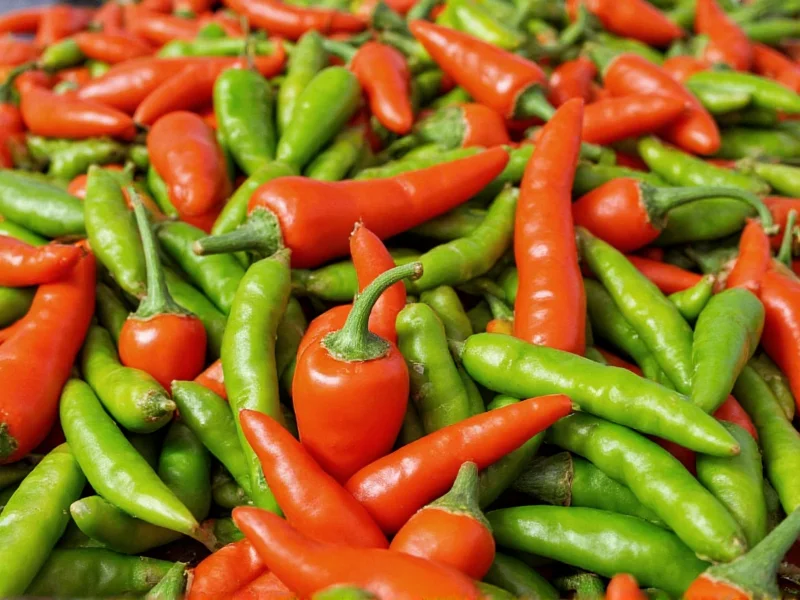When you bite into a habanero pepper, you're experiencing heat that ranks significantly hotter than common jalapeños but milder than extreme peppers like the ghost pepper. The Scoville scale quantifies chili pepper pungency by measuring capsaicin concentration—the compound responsible for that fiery sensation.
Understanding Habanero Heat Levels
The habanero's heat range of 100,000-350,000 SHU represents substantial variability. This variation occurs because multiple habanero varieties exist, including the popular orange habanero, red savina habanero, and chocolate habanero. Environmental factors like soil composition, climate, and water stress significantly impact capsaicin production in chili plants.
For context, consider these heat comparisons:
| Pepper Variety | Scoville Heat Units (SHU) | Relative Heat Comparison |
|---|---|---|
| Habanero | 100,000-350,000 | 30-100x hotter than jalapeño |
| Jalapeño | 2,500-8,000 | Baseline for comparison |
| Serrano | 10,000-23,000 | 2-5x hotter than jalapeño |
| Ghost Pepper | 855,000-1,041,427 | 2-8x hotter than habanero |
| Carolina Reaper | 1,400,000-2,200,000 | 4-15x hotter than habanero |
Why Habaneros Have Such a Wide Heat Range
Several factors contribute to the broad Scoville measurement for habaneros:
- Varietal differences: The red savina habanero, once recognized as the world's hottest pepper, typically measures near the upper end of the range (around 500,000 SHU), while standard orange habaneros usually fall in the middle.
- Growing conditions: Peppers develop more capsaicin when stressed—drought conditions or nutrient-deficient soil can increase heat levels significantly.
- Ripeness: Fully ripe red or orange habaneros tend to be hotter than their green, unripe counterparts.
- Plant position: Peppers growing on the top of the plant often receive more sun and develop higher heat levels.
Practical Implications of Habanero Heat
Understanding habanero Scoville measurements isn't just academic—it has real culinary consequences. When working with habaneros, always:
- Wear gloves to prevent capsaicin transfer to sensitive areas
- Remove seeds and white membranes (placenta) where most capsaicin concentrates
- Start with small amounts and adjust to taste—remember that heat perception varies between individuals
- Have dairy products like milk or yogurt nearby to neutralize capsaicin if needed
Habanero Flavor Beyond the Heat
While habaneros are famous for their heat, they also offer complex flavor profiles that distinguish them from other hot peppers. Most habaneros feature distinct fruity, citrusy, or floral notes—particularly the popular orange variety. This flavor complexity makes them valuable in hot sauces, salsas, and Caribbean cuisine where their heat is balanced with complementary flavors.
The Yucatan Peninsula in Mexico remains a primary growing region for habaneros, where local varieties have adapted to the tropical climate. Interestingly, the name "habanero" actually means "from Havana," reflecting the pepper's historical trade route rather than its origin.
Measuring Pepper Heat Accurately
Modern laboratories use high-performance liquid chromatography (HPLC) to measure capsaicinoids precisely, then convert these measurements to Scoville units. This scientific approach has replaced the original subjective Scoville Organoleptic Test, which relied on human tasters diluting pepper extracts until heat became undetectable.
When researching habanero heat levels, look for sources that cite laboratory testing rather than anecdotal reports. Reputable agricultural extensions and peer-reviewed studies provide the most reliable Scoville measurements for specific habanero varieties.
Working Safely with High-Heat Peppers
If you're handling habaneros for cooking, remember that capsaicin can linger on surfaces and cause irritation hours later. Always wash cutting boards, knives, and hands thoroughly with soapy water after preparation. Never touch your face while handling hot peppers, and consider using eye protection when working with multiple habaneros.
For those building heat tolerance, habaneros serve as an excellent intermediate step between milder peppers like serranos and extreme varieties like ghost peppers. The substantial heat range means you can find habanero varieties that match your personal tolerance while still experiencing their distinctive flavor profile.
What is the average Scoville rating for a standard habanero pepper?
The average habanero pepper typically measures around 225,000 Scoville Heat Units, though this varies significantly by variety and growing conditions. Most standard orange habaneros fall between 150,000-300,000 SHU, while the red savina variety often reaches 400,000-500,000 SHU.
How does habanero heat compare to other popular hot peppers?
Habaneros are approximately 30-100 times hotter than jalapeños (2,500-8,000 SHU), 5-15 times hotter than serranos (10,000-23,000 SHU), and about 2-8 times milder than ghost peppers (855,000-1,041,427 SHU). They're significantly less hot than record-breaking peppers like the Carolina Reaper (1.4-2.2 million SHU).
Why do some habaneros taste hotter than others even from the same plant?
Heat variation occurs within the same plant due to several factors: peppers at the top of the plant receive more sunlight and typically develop higher capsaicin levels; the amount of water and nutrients available affects heat production; and individual pepper maturity influences spiciness, with fully ripe peppers generally being hotter than unripe ones.
Can cooking reduce a habanero's Scoville rating?
Cooking doesn't significantly reduce a habanero's Scoville rating as capsaicin is heat-stable. However, when incorporated into dishes with fats, sugars, or acids, the perceived heat diminishes as these components bind with capsaicin. The actual Scoville measurement remains unchanged, but the eating experience becomes more manageable.
What's the mildest variety of habanero available?
The White Habanero (also called Habanada) is specifically bred to be mild while retaining habanero flavor characteristics, measuring only 0-500 SHU. Among traditional habaneros, the Yellow Habanero tends to be milder than red or chocolate varieties, typically ranging from 100,000-200,000 SHU rather than the upper range of 300,000+ SHU.











 浙公网安备
33010002000092号
浙公网安备
33010002000092号 浙B2-20120091-4
浙B2-20120091-4